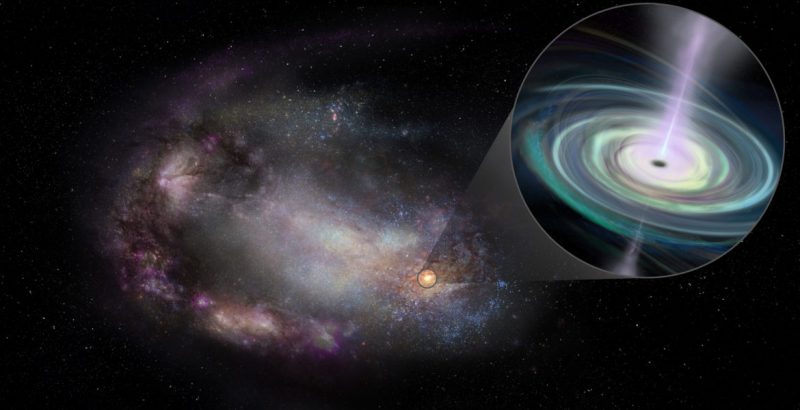

Artist’s conception of a dwarf galaxy, its shape distorted, most likely by a past interaction with another galaxy, and a massive black hole in its outskirts (bright spot, far right). Image via Sophia Dagnello, NRAO/ AUI/ NSF
A team of astronomers have spotted 13 massive black holes in dwarf galaxies less than a billion light-years from Earth. The astronomers announced the discovery at this week’s American Astronomical Society annual meeting in Honolulu, Hawai’i.
According to the astronomers, these dwarf galaxies, more than 100 times less massive than our own Milky Way, are among the smallest galaxies known to host massive black holes. They expect that the black holes in these smaller galaxies average about 400,000 times the mass of our sun.
The astronomers used the Karl G. Jansky Very Large Array (VLA) Observatory to make the discovery. Amy Reines of Montana State University is lead author of the new study, published January 3, 2020 in the Astrophysical Journal. She said in a statement:
The new VLA observations revealed that 13 of these galaxies have strong evidence for a massive black hole that is actively consuming surrounding material. We were very surprised to find that, in roughly half of those 13 galaxies, the black hole is not at the center of the galaxy, unlike the case in larger galaxies.
According to the scientists, this suggests that the galaxies likely merged with other galaxies earlier in their history. The theory is consistent with computer simulations predicting that roughly half of the massive black holes in dwarf galaxies will be found wandering in the outskirts of their galaxies. Reines said:
This work has taught us that we must broaden our searches for massive black holes in dwarf galaxies beyond their centers to get a more complete understanding of the population and learn what mechanisms helped form the first massive black holes in the early universe.
Reines added:
We hope that studying them and their galaxies will give us insights into how similar black holes in the early universe formed and then grew, through galactic mergers over billions of years, producing the supermassive black holes we see in larger galaxies today, with masses of many millions or billions of times that of the sun.
Read more about how the astronomers made the discovery
Bottom line: Astronomers discovered 13 massive black holes in dwarf galaxies.
Via National Radio Astronomy Observatory.
from EarthSky https://ift.tt/37Urej6


Artist’s conception of a dwarf galaxy, its shape distorted, most likely by a past interaction with another galaxy, and a massive black hole in its outskirts (bright spot, far right). Image via Sophia Dagnello, NRAO/ AUI/ NSF
A team of astronomers have spotted 13 massive black holes in dwarf galaxies less than a billion light-years from Earth. The astronomers announced the discovery at this week’s American Astronomical Society annual meeting in Honolulu, Hawai’i.
According to the astronomers, these dwarf galaxies, more than 100 times less massive than our own Milky Way, are among the smallest galaxies known to host massive black holes. They expect that the black holes in these smaller galaxies average about 400,000 times the mass of our sun.
The astronomers used the Karl G. Jansky Very Large Array (VLA) Observatory to make the discovery. Amy Reines of Montana State University is lead author of the new study, published January 3, 2020 in the Astrophysical Journal. She said in a statement:
The new VLA observations revealed that 13 of these galaxies have strong evidence for a massive black hole that is actively consuming surrounding material. We were very surprised to find that, in roughly half of those 13 galaxies, the black hole is not at the center of the galaxy, unlike the case in larger galaxies.
According to the scientists, this suggests that the galaxies likely merged with other galaxies earlier in their history. The theory is consistent with computer simulations predicting that roughly half of the massive black holes in dwarf galaxies will be found wandering in the outskirts of their galaxies. Reines said:
This work has taught us that we must broaden our searches for massive black holes in dwarf galaxies beyond their centers to get a more complete understanding of the population and learn what mechanisms helped form the first massive black holes in the early universe.
Reines added:
We hope that studying them and their galaxies will give us insights into how similar black holes in the early universe formed and then grew, through galactic mergers over billions of years, producing the supermassive black holes we see in larger galaxies today, with masses of many millions or billions of times that of the sun.
Read more about how the astronomers made the discovery
Bottom line: Astronomers discovered 13 massive black holes in dwarf galaxies.
Via National Radio Astronomy Observatory.
from EarthSky https://ift.tt/37Urej6

Aucun commentaire:
Enregistrer un commentaire